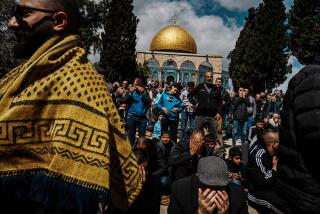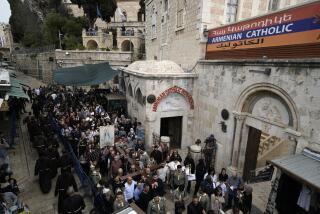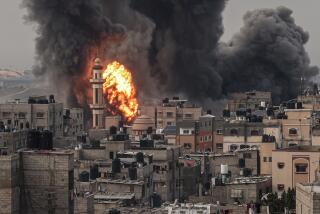Jerusalem, where the spirit moves
To me, travel means trying to understand places, appreciating them for what they are, and making them my own. But sometimes my ability to do that breaks down.
It happened in Jerusalem, one of the oldest, most revered and emotional cities in the world. Modern West Jerusalem, with its restaurants, shops, hotels and museums, was not the problem.
But the Old City -- a 0.35-square-mile patch of stony hilltop covered with churches, mosques and synagogues wrapped in thick Ottoman walls -- made my heart sick, which was not the way I wanted to feel in Jerusalem with Christmas coming.
At one point during my weekend stay I called my sister-in-law, Susan, an Episcopalian clergywoman, who said that Jerusalem was for pilgrims, not tourists, however drawn they may be to the city’s history and theology.
Maybe she was right. Maybe only people who come with unwavering faith can handle the Old City.
Without it, the contest to own Jerusalem that has been waged by Jews, Muslims and Christians since the time of the Crusades remains palpable enough to confirm the disbelief of an atheist.
For someone like me, who was brought up Christian but had the kind of liberal education that opens the mind to what is useful and good in all religions, visiting Jerusalem can be wrenching.
It is, of course, the holy of holy for Jews, because it is thought to be where Abraham proved himself willing to sacrifice his son to God.
About 2,000 years ago, a child born in the nearby village of Bethlehem was recognized by early Christians as the Messiah foretold in Jewish scripture. The Via Dolorosa in the Old City follows the path he took to his crucifixion.
The city’s Muslim meaning is established in passages of the Koran describing the prophet Muhammad’s night journey. It says the Angel Gabriel told him to ride to the mosque farthest from Mecca, which is thought to have been on Temple Mount in Jerusalem.
The Old City’s political history has even more layers. Since 1900 alone, it has been ruled by Ottoman Turks; the British; Jordan, which claimed the Old City in 1948; and Israel, which took it back after the 1967 Six-Day War.
If the Cliff Notes version of Jerusalem seems fairly cut-and-dried, the story on the ground is anything but. Even on a peaceful and sunny November weekend, I felt currents of the latest tug-of-war for Jerusalem between Israelis and Palestinians.
On a Friday afternoon I sped into town from a Tel Aviv suburb, where I’d dropped my friend Penny at her sister’s house, regretfully declining an invitation to join them for Shabbat dinner.
But I wanted to reach Jerusalem by dark when Jews congregate at the Western Wall, all that remains of the Second Temple, destroyed by the Romans in AD 70.
When I arrived, I parked and headed for Damascus Gate on the north side of the Old City. To find it, I followed the streams of black-hatted Hasidim racing toward the wall to welcome the Sabbath at sunset.
Surrounded by a bustling street market, Damascus Gate leads through the dense, dark, souk-like Muslim Quarter, across an intersection with the Via Dolorosa, through a tunnel and security checkpoint to the Western Wall Plaza.
The open, amphitheater-like space was crowded with Israeli soldiers, sightseers and worshipers.
Near the cordon delimiting the male section of the wall, a scene like no other in the world unfolded: Men prayed, bowed, danced and wept in a full range of Jewish garb.
Only later, when I read Thomas L. Friedman’s “From Beirut to Jerusalem,” did I begin to fathom the difference between the crocheted yarmulkes of modern Orthodox Jews and the fur hats of the ultra-Orthodox Hasidim.
A woman standing next to me, part of a group from the Jewish Federation of South Palm Beach County in Florida, extended another Shabbat invitation. But I was physically exhausted and, I think, tired of feeling more voyeur than sightseer.
Instead I bought hummus and pita bread in the market, then checked into a bed and breakfast about five minutes north of Damascus Gate.
Maga’s House, as it is called, occupies the lower part of a rambling old mansion on Heleni Hamalka Street in the Musrara district, which sits on the border between what was Israeli West Jerusalem and Jordanian East Jerusalem before 1967. Among the accommodations in this B&B was a renovated 19th century cistern.
This was one of the strangest places I’ve ever stayed.
The apartment is entered by a spiral staircase that leads to a bedroom on the first level, below ground.
The primitive bath is on the next level down, followed by a big living room and kitchen at the bottom. The cistern has a skylight and lamps, but it still felt like a bomb shelter. I was amused to learn that before Maga turned the cistern into an apartment, it was an 80-seat jazz club.
I contemplated leaving the next day, but slept soundly that night. And then I met Maga, who lives in an adjacent apartment and made the experience of staying there worthwhile. She is a psychotherapist who came to Israel from Argentina in the 1960s.
I arrived at the Jaffa Gate on the west side of the Old City early enough the next day to be one of the first people on a nearby section of the ramparts that’s open to tourists.
The view to the right is of the Christian quarter, to the left of modern, western Jerusalem, shelled by Jordanians from the ramparts, a sign said.
Just south of Jaffa Gate is King David’s Tower, once a Crusader castle, now a history museum, instructive, but hardly as compelling as the real thing at its feet.
Sightseeing company Sandemans New Jerusalem offers free 3 1/2 -hour walking tours that start at Jaffa Gate. I joined one of them, led by a smart, young Hebrew University student who explained that around 1900, Europeans began buying property in Jerusalem where they established churches and hostels.
Some of the best guest houses and cafes are still run by religious institutions, including the Austrian Hospice and French Ecce Homo Convent in the Muslim Quarter.
The guide led my group through a labyrinth of alleyways and up crumbling staircases to the rooftop of the city near where its four quarters meet.
Here we got a sweeping view of the Church of the Holy Sepulchre, Western Wall Plaza and Temple Mount, surmounted by the gleaming gold hemisphere of the Dome of the Rock.
Looking closer we could see how the densely packed warrens of the Muslim Quarter differed from the lighter, more orderly Jewish Quarter, destroyed during the Jordanian period but later skillfully reconstructed by the Israelis.
There is a mosque in the Christian Quarter and an Anglican hospice in the Armenian. Our guide said that Muslims aren’t welcome to live in the Jewish Quarter but several ultra-Orthodox Jews recently moved into the Muslim area. Together with several Israeli government development projects, this has been seen by Palestinians as part of an effort to “Judaicize” Arab East Jerusalem in order to influence negotiations about the ultimate disposition of the city.
After the tour I visited the Church of the Holy Sepulchre, which even quibbling archaeologists tend to agree is the site of Christ’s crucifixion and burial. It is a dark, cave-like place, gerrymandered among different Christian sects. I got there just as the Greek Orthodox Patriarch of Jerusalem was arriving with acolytes, and a Coptic Christian woman was weeping over the stone slab where it’s thought Jesus’ brutalized body was laid.
Then I walked the Via Dolorosa backward and found my favorite place in Old Jerusalem, the sixth Station of the Cross, where Veronica wiped Christ’s forehead with her veil.
The next day I toured Temple Mount with a dapper Muslim guide who took me to the west side of the Al-Aqsa Mosque, which is closed to non-Muslims and women. But through a little window there I could scrutinize the empty space inside, supported by Italian marble columns donated by Mussolini.
The plaza around the mosque is an uplifting, airy place shaded by old olive trees and illuminated by the golden Dome of the Rock, which tourists can make little sense of because they aren’t allowed to enter.
From there I made my way through St. Stephen’s Gate on the east side of the Old City, heading toward the Mount of Olives, a rocky hill mostly covered by a Jewish cemetery where plots are worth millions, I heard.
The hill -- mountain is too big a word for it -- is a stop for phalanxes of tour buses because it is thought to be the site of the Garden of Gethsemane, where Christ almost lost faith before going to his crucifixion.
A chain of sanctuaries has been built there by Christians from many nations. Along the winding lane leading to the top, a huckster with a white donkey poses for pictures with pilgrims.
Near the summit is the Church of Dominus Flevit, commemorating the place where, weeping over Jerusalem, Christ said, “If this day you only knew what makes for peace. But it is hidden from your eyes.”
Now, as then.
Who would not shed a few tears standing on the Mount of Olives looking over Jerusalem?
susan.spano@latimes.com
More to Read
Sign up for The Wild
We’ll help you find the best places to hike, bike and run, as well as the perfect silent spots for meditation and yoga.
You may occasionally receive promotional content from the Los Angeles Times.






